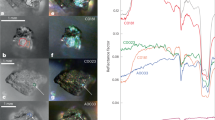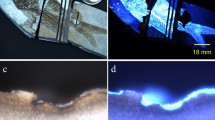Abstract
The criticism by Pasteris and Wopenka of our use of laser–Raman imagery to investigate the carbonaceous make-up of extremely ancient fossils1 focuses only on their Raman signature; however, our interpretation that the carbonaceous matter that makes up these specimens is biogenic is based on several lines of evidence, of which Raman spectroscopy is only one.
Similar content being viewed by others
Schopf et al. reply
We did not state, nor did we imply, that Raman spectroscopic analysis can by itself be used to establish the biological origin of geochemically highly altered carbonaceous matter present in ancient sediments. We believe that the biogenicity of such matter, whether in fossil-like objects or sapropel-like detritus, should be demonstrated by a combination of data drawn from independent but mutually reinforcing lines of evidence.
For fossils in each of the four geological units we analysed1 — including those of the roughly 3,375-million-year (Myr)-old Kromberg Formation and 3,465-Myr-old Apex Chert, which are among the oldest fossils known — three lines of evidence are most compelling. These are their cellular morphology2,3, their carbonaceous molecular-structural make-up1,2,3,4, and the carbon isotope composition of such fossils5 and/or of co-existing particulate kerogen6,7, which have been shown by replicate analyses5,6,7 to be well within the range established for Precambrian biological organic matter on the basis of over 1,200 measurements from hundreds of fossil-bearing units7.
Our study1, which focuses on the first two of these lines of evidence, is centred on the use of laser–Raman imagery (rather than on more conventional single-point measurements), a technique new to palaeobiology1,4. We showed that there is a one-to-one correlation of cellular morphology and carbonaceous make-up in individual microscopic fossils from each of the four units investigated. Our claim is that such an analysis based on a combination of morphology and chemistry together provides a powerful new means to investigate the biogenicity of putative fossil-like objects, a problem that for many decades has plagued the search for evidence of early life8.
References
Schopf, J. W., Kudryavtsev, A. B., Agresti, D. G., Wdowiak, T. J. & Czaja, A. D. Nature 416, 73–76 (2002).
Schopf, J. W. in The Proterozoic Biosphere, a Multidisciplinary Study (eds Schopf, J. W. & Klein, C.) 25–39, 1055–1117 (Cambridge Univ. Press, New York, 1992).
Schopf, J. W. Science 260, 640–646 (1993).
Kudryavtsev, A. B., Schopf, J. W., Agresti, D. G. & Wdowiak, T. J. Proc. Natl Acad. Sci. USA 416, 73–76 (2002).
House, C. H. et al. Geology 28, 707–710 (2000).
Strauss, H. & Moore, T. B. in The Proterozoic Biosphere, a Multidisciplinary Study (eds Schopf, J. W. & Klein, C.) 709–798 (Cambridge Univ. Press, New York, 1992).
Strauss, H., Des Marais, D. J., Hayes, J. M. & Summons, R. E. in The Proterozoic Biosphere, a Multidisciplinary Study (eds Schopf, J. W. & Klein, C.) 117–127 (Cambridge Univ. Press, New York, 1992).
Schopf, J. W. & Walter, M. R. in Earth's Earliest Biosphere, its Origin and Evolution (ed. Schopf, J. W.) 214–239 (Princeton Univ. Press, Princeton, New Jersey, 1983).
Author information
Authors and Affiliations
Corresponding author
Rights and permissions
About this article
Cite this article
Schopf, J., Kudryavtsev, A., Agresti, D. et al. Images of the Earth's earliest fossils?. Nature 420, 477 (2002). https://doi.org/10.1038/420477a
Issue Date:
DOI: https://doi.org/10.1038/420477a
Comments
By submitting a comment you agree to abide by our Terms and Community Guidelines. If you find something abusive or that does not comply with our terms or guidelines please flag it as inappropriate.



